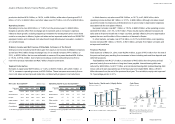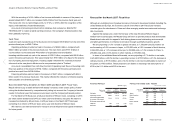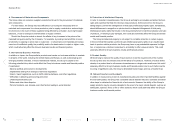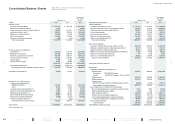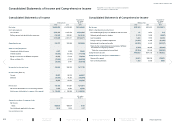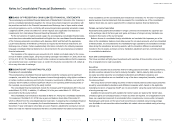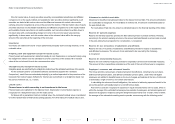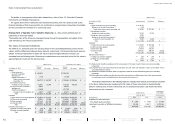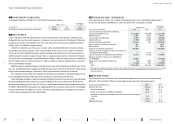Mazda 2016 Annual Report Download - page 55
Download and view the complete annual report
Please find page 55 of the 2016 Mazda annual report below. You can navigate through the pages in the report by either clicking on the pages listed below, or by using the keyword search tool below to find specific information within the annual report.
If the fair market value of equity securities issued by unconsolidated subsidiaries and affiliated
companies not on the equity method and available-for-sale securities declines significantly, such
securities are stated at fair market value and the difference between fair market value and the
carrying amount is recognized as a loss in the period of the decline. If the fair market value of equity
securities issued by unconsolidated subsidiaries and affiliated companies not on the equity method
and available-for-sale securities is not readily available, such securities should be written down to
net asset value with a corresponding charge to income in the event net asset value declines
significantly. In these cases, such fair market value or the net asset value will be the carrying
amount of the securities at the beginning of the next year.
Inventories
Inventories are stated at the lower of cost (determined principally by the average method), or net
realizable value.
Property, plant and equipment (except for leased assets)
Property, plant and equipment are stated principally at cost. Depreciation is computed mainly using
the straight-line method over the estimated economic useful lives of the assets with a residual
value at the end of useful lives to be a memorandum value.
Intangible assets (except for leased assets)
Intangible assets are amortized by the straight-line method over the estimated useful lives of the assets.
For the Company and its consolidated domestic subsidiaries (together the “Domestic
Companies”), useful lives are estimated principally by a method equivalent to the provisions of the
Corporate Tax Code of Japan. Software for internal use is amortized on a straight-line basis over
the period of internal use, i.e., 5 years.
Leased assets
Finance leases in which ownership is not transferred to the lessee
Finance leases are capitalized in the balance sheet. Depreciation or amortization expense is
recognized on a straight-line basis over the lease period.
For leases with a guaranteed minimum residual value, the contracted residual value is considered
to be the residual value for financial accounting purposes. For other leases, the residual value is zero.
Allowance for doubtful receivables
Allowance for doubtful receivables provides for the losses from bad debt. The amount estimated to
be uncollectible is recognized. For receivables of ordinary risk, the amount is estimated based on
the past default ratio.
For receivables of high risk, the amount is estimated based on the financial standing of the debtor.
Reserve for warranty expenses
Reserve for warranty expenses provides for after-sales expenses to product (vehicle). Primarily,
according to the product warranty provisions, the amount estimated based on actual costs incurred
in the past, taking future prospects into consideration, is recognized.
Reserve for loss on business of subsidiaries and affiliates
Reserve for loss on business of subsidiaries and affiliates provides for losses on subsidiaries
and affiliates’ businesses. The amount of loss estimated to be incurred by the Company
is recognized.
Reserve for environmental measures
Reserve for environmental measures provides for expenditure aimed at environmental measures.
The amount of future expenditure estimated as of the end of the current fiscal year is recognized.
Employees’ severance and retirement benefits
The Group provides various types of post-employment benefit plans, including lump-sum plans,
defined benefit pension plans, and defined contribution pension plans, under which all eligible
employees are entitled to benefits based on the level of wages and salaries at the time of retirement
or termination, length of service, and certain other factors.
In calculating the retirement benefit obligations, the method of attributing expected benefit to the
accounting period is principally based on a benefit formula basis.
Past service costs are recognized in expenses in equal amounts mainly over 12 years, which is
within the average of the estimated remaining service periods of employees, and actuarial gains and
losses are recognized in expenses using the straight-line basis mainly over 13 years, which is within
the average of the estimated remaining service periods, commencing with the following period.
Notes to Consolidated Financial Statements
MAZDA ANNUAL REPORT 2016
53 Financial Section
Message from
Management
Review of Operations
Drivers of Value Creation
Foundations Underpinning
Sustainable Growth
Contents


